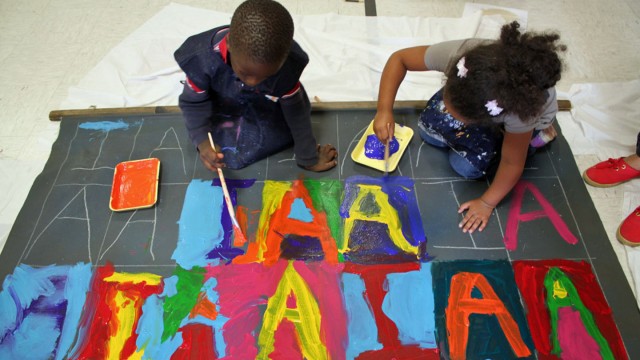available for purchase
at this time.
Link Roundup! – 2/13/15
Link Roundups feature articles and bits of internet goodness that our dramaturgy team digs up. If you find something you want to send our way, drop us a line on Facebook or Twitter!
♦♦♦♦♦

Kindergartners at Wheeler paint the backdrop for their school photos. (Courtesy of Ada Leaphart/Integrated Arts Academy at H.O. Wheeler)
This piece about the Integrated Arts Academy in Vermont combining the arts with math, science, social studies and other curriculum really highlights the importance of creativity in the classroom:
What does art integration look like? Recently, a fourth-grade lesson on geometry examined the work of the famous Russian artist Wassily Kandinsky. The class talked about his work and then created their own art using angles in the style of Kandinsky. Students had to be able to identify the angles they’d used and point them out in their art.
“Higher analytical thinking and reasoning and student voice fit so well with the arts,” said Bobby Riley, the school’s principal. Teachers are seeing ways to make connections between subjects and watch as students find creative confidence and voice in their expression.
♦♦♦♦♦
The Boston Globe has an interview with Julie Burros, the new arts and culture chief, about her plans for Boston and what she’s learned about the city’s cultural scene since taking office:
On the relationship between the arts and income inequality, I’m curious to know: Can you use arts and culture to address that growing problem?
Maximizing people’s creative capital could help create income opportunities for people who maybe don’t see themselves fitting into the four-year college track or the corporate world. There’s another relationship in, how can unlocking people’s creative tools help them be more employable, more well-rounded employees for all different kinds of industries? And then there’s just the appeal factor. If we have more robust arts and culture offerings in our schools, it could keep kids in school longer.
♦♦♦♦♦
Howard Sherman recently blogged about an experience he had at a post-show event and asks some good questions about how organizations are really engaging with their audiences:
“I’m going to see if others come to talk,” I said, “Let me wait until others get here.”
No one else came.
I waited for 15 minutes, and not a single customer of any kind entered the restaurant, let alone fellow theatregoers. No staff from the theatre turned up either, and I stood there awkwardly, not wanting to take a table and then disappoint a server when I failed to order, my interest in hearing about or discussing the play waning as I pondered the reasons for my solitude.
♦♦♦♦♦
If you’re looking for some reading or dancing material to pass the time during the upcoming snowstorm, check out this Black History Month soundtrack or a list of The 10 Best Reads For Black History Month.
